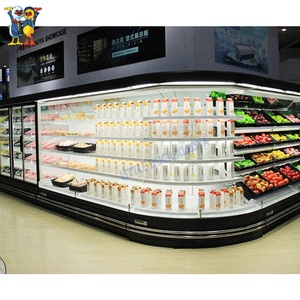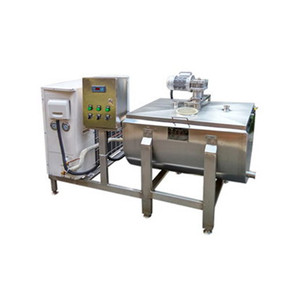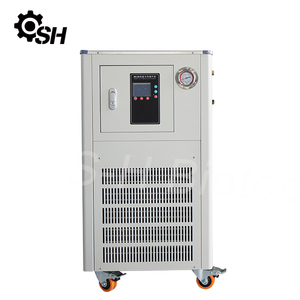(5035 products available)








































































































































































































Chillers for milk are available in a variety of types and sizes, each of which is suitable for different applications. The following table describes some of the more common types of milk chillers.
Proper maintenance of a milk chiller is crucial to ensuring milk quality and the longevity of the chillers. The frequency of maintenance required for a milk chiller is largely dependent upon its size and the environment in which it is kept. Chillers in larger dairy farms should be cleaned daily to ensure no milk residue builds up. All parts of the chiller should be cleaned using warm water and detergent and rinsed thoroughly. Detergents used should be made for dairy equipment and should be thoroughly rinsed to prevent contamination. Smaller chillers used in homes or small-scale farms should be cleaned every time a new batch of milk is added. The interior of the chiller should be made of food-grade materials, which makes it easy to clean with non-abrasive materials without damaging it.
Regular cleaning and maintenance of the milk chiller can help identify small issues before they become major problems. The milk chiller should be inspected for leaks, damaged components, and abnormal noises. All parts should be checked to ensure they are working properly, including the refrigeration system, fans, controls, and sensors. Any issues should be reported to a professional repair service immediately.
The milk chiller should be placed in an area where there is proper ventilation. This is essential in maintaining the performance and efficiency of the chiller. A well-ventilated area allows for constant airflow around the chiller. Regular cleaning of the condenser and evaporator coils also helps ensure the efficient operation of the chiller by preventing the buildup of dust and debris. The chiller should be positioned on a level surface to avoid vibration and noise. Additionally, the power supply and electrical connections should be inspected to ensure they are safe and secure. This helps prevent electrical hazards and power surges that can damage the chiller.
A milk chiller is an essential piece of equipment in the dairy and beverage industries. However, it has other applications in various industries.
In the agriculture industry, a milk cooler can be used to store and preserve perishable produce such as fruits, vegetables, and flowers. Chilling these items helps to maintain their freshness for longer, thus extending their shelf life and reducing waste.
In the food processing industry, chillers can be used to cool down food products quickly after cooking or processing. This rapid cooling helps to preserve the quality of the food by locking in flavors and nutrients. It also prevents bacterial growth and spoilage. Some of the food items that benefit from rapid cooling with a milk chiller include baked goods, confectionery items, and meat products.
In the pharmaceutical industry, a milk cooler can be used to store temperature-sensitive drugs, vaccines, and biological samples. These items require precise temperature control to maintain their efficacy and integrity. A chiller with advanced monitoring and control systems can provide a stable and controlled storage environment, thus preserving the potency of the pharmaceutical products.
The plastics and rubber industry uses milk chillers to cool down molten plastic or rubber during the manufacturing process. This rapid cooling helps to solidify the material quickly into the desired shape, improving efficiency and production speed. It also enhances the final product's quality by reducing defects such as warping and shrinkage.
In the chemical processing industry, a milk cooler can be used to maintain the temperature of reactors and other equipment. It also enables the quick cooling of chemical compounds after a reaction, allowing for better process control and product quality.
In the energy sector, chillers are used to cool down equipment such as gas turbines and power generators. Maintaining these devices at optimal operating temperatures enhances their efficiency and lifespan. Some milk chillers can also be used for distillation processes, which require precise temperature control to separate different components of a liquid mixture.
When choosing a milk chiller for sale, it is important to consider the following factors.
It is vital to consider the chiller's storage capacity and determine the amount of milk it can store. This will depend on the volume of the customer's traffic. Customers with a high volume of traffic may opt for a chiller with a large capacity to ensure they meet the demand. On the other hand, those with low traffic may choose a chiller with a low capacity volume.
It is important to choose the type of cooling system that suits the specific needs. Direct expansion coolers are ideal for those who want a quick cool-down time and constant temperature. On the other hand, if the customer is looking for a chiller that is quiet and has no moving parts, a chilled water system would be ideal. For those looking for something that does not take up much space, a chiller with an air-cooled condenser would be ideal.
Choosing an energy-efficient chiller can help minimize operating costs. Customers can opt for a chiller with extra energy-saving features like automatic temperature controls and insulated doors. This prevents the chiller from cooling the interior when the door is open and prevents the door from having an ice buildup. Choosing a chiller with smart energy management systems is also an excellent way to monitor and optimize energy usage.
Customers can choose a chiller based on their budget. They can choose from different models with varying prices and select the one that best fits their budget.
Q1: What is the best way to store milk in a cooler?
A1: It is best to store milk at 4°C or lower to maintain its freshness. Storing milk at high temperatures can lead to spoilage, which can be harmful to health.
Q2: Why do people need to chill milk?
A2: Chilling milk is necessary to maintain its nutritional value and freshness. If left at room temperature, bacteria can grow in milk, causing it to spoil and potentially leading to health hazards.
Q3: How long can someone keep milk in a chiller?
A3: The duration for which milk can be kept in a chiller depends on the type of chiller and the temperature at which it is stored. Typically, pasteurized milk can be kept in a chiller for up to 2 to 3 weeks. However, it is advisable to check the milk's smell and taste before consumption.
Q4: How do chillers work for milk?
A4: Milk chillers work by transferring heat out of the milk to the surrounding environment. This process keeps the milk at a consistent low temperature. The chiller's refrigeration system plays a vital role in this process. It removes heat from the milk and releases it outside, ensuring the milk stays cool.